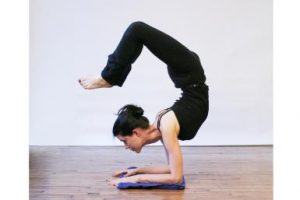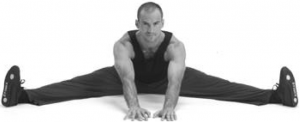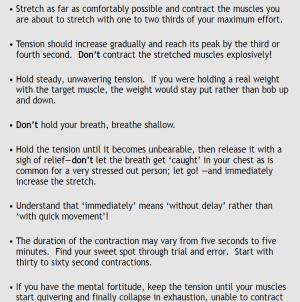In a previous article, I discussed stretching—namely, why stretching is important for the masculine man, and several stretches that you should use in your training to maximize your physical fitness. And while that advice is still valid, I neglected a very important concept in that first article: the techniques that detail how to stretch.
I am not referring to a specific stretch or some sort of hypothetical “stretching mindset,” but rather a set of techniques that can be utilized for any stretch to increase ones flexibility immediately. But before I can discuss those, I have to discuss the incorrect way of stretching that many people still use.
How Not To Stretch
Many people believe that stretching is a literal act of forcing the muscles and connective tissue to stretch—avoid this at all costs! First and foremost, as I have discussed previously in these pages, you should never apply any stretching pressure to the connective tissue. They evolved solely to “hold fast” and keep things in one piece, they should never be stretched at all!
The muscles are the anatomical feature that stretches, as they evolved to do. When stretching, your body should always be positioned in a way where the connective tissues are stable and the muscles are moving.
Even when you are positioned properly, no part of stretching should involve the athlete forcing his muscles to stretch, as that risks muscular tearing which is a nagging injury that never truly goes away. This is because the human body has naturally evolved what is referred to as the “anti-stretch reflex” to prevent muscular tearing-stretching the muscles increases in difficulty the farther and deeper the stretch is, and your body responds to this stress with pain. This is a biological sign telling you that if you go further you’ll be risking muscle tears, and should normally be a heeded warning.
However, if you want to do advanced stretching (such as that nigh-impossible benchmark of fitness the splits), you will have to find a way to overcome this reflex without hurting yourself. And as luck would have it, there is!

Relax Into Stretching
Reflexes can be overcome with gradual and repeated practice—just ask your friendly neighborhood hooker about how she overcame her gag reflex! Similarly, your anti-stretch reflex that keeps your “joints” (actually your muscles) stiff and immobile can be overcome with a few techniques.
The most basic of these techniques is the one that I have had the best results with (as usual, the simple but difficult answer is usually the correct one), and that is the titular concept of “relaxing into a stretch”—with thanks to Pavel Tsatsouline for naming the concept.
To use this technique, take an easy form of the stretch you want to do: using the splits as an example, you would do a seated groin stretch. Engage the stretch just to the point where you feel tension in the target muscle, and then…sit and wait.

Yes, paradoxically, relaxation is the key to increasing your physical fitness in this context. You are literally going to sit there and wait for your muscles to stop fighting the stretch—in other words, you’re going to exhaust your reflex until it stops being reflexive.
This is not something that happens quickly—from my experience, it will take 5-10 minutes per stretch, so it is perfectly acceptable for you to get a book or watch TV while doing this. As a side note, this is literally the only time where it’s acceptable to have a visual distraction during exercise, in my opinion.
As you might expect, once your muscles have relaxed and the pain has melted away, you can increase the stretch a little bit more, and hold it for another 10 minutes. Repeat this process until your muscles are in pain and you judge that you can’t go any further—this is a personal call that you will have to decide for yourself, as I can’t judge when your muscles are demanding you to stop.
This technique can be utilized for any stretch, and in many cases will give you the progress that you so desire. However, there are other methods in the “Relax Into Stretch” family of exercises that can be utilized as well, such as meditation—mentally relaxing will lead to muscular relaxation.
Or you can try “forced relaxation”, where you flex the muscle simultaneously while stretching, forcing the muscle to relax.

Either way you slice it, don’t just brute force your stretching, utilize these techniques for better results.
Read More: Why Stretching Is Essential For The Body (With 6 Beginner Stretches To Get You Started)
I think we need to get over this misconception that great flexibility is a sign of ‘fitness’. A man can improve his stamina and strength a lot and he can improve his flexibility a bit but most men should not strive for extreme flexibility; it reduces power production and is mostly a waste of time because in our adult years our bodies are already set and flexibility is the one quality that’s the hardest to attain at that point and no; working hard on it is NOT the answer depending on your build.
It’s not the only sign of fitness, but its still worth doing. Plus it can help those other two aspects.
Greater mobility = greater momentum. Having a full range of motion is an advantage in any sport, and certainly for martial arts as well.
On the other hand, stiffness can often be a sign of strength, (thicker muscle fibers, stronger ligaments, etc.), so the strong man who can make himself even a little bit flexible would have a huge advantage over the average guy who is more flexible by nature but lacks power and explosivenes…
Everybody has weak and strong sides (basics); stretching ahead of a workout informs you as to which weak-side parts are lagging their stronger counterparts. Since I tend to begin the workout with this subtle L/R lopsidedness, I go for light stretching to “set the balance,” wake up my weaker L side and put it into agreement with the R side (which always seems to be more ready-to-go at all times).
After running and lifting weights, I finish with a more extensive 15-minute yoga-style or track-and-field style set of higher-intensity stretches with longer-duration hold times, to once again reset the “new balance” from L/R + top/bottom post-workout.
This always leaves me walking away feeling like I’m properly “wrung out” and balanced from core to extremities.
Last bit of advice is a common one: Get out of your chair during the day as much as possible and don’t lounge in it (or couches, etc.) too long. Every muscle from your mid-back to calves will reward you for the effort.
I thought this would be boring, but it’s quite insightful. I think you can adapt this to a lot of stuff. Like keeping a cool mind when in stressful situations, because you can then better deal with them. (Not a perfect analogy, but I think it’s kinda valid nonetheless)
I have often tried to ‘power through’ the pain, but in hindsight, the best results I got with anything in life were always when I listened to my body.
Third picture down is Pavel Tsatsouline, mentioned in the article, former Soviet Special Forces instructor, author of Relax into Stretch: Instant Flexibility Through Mastering Muscle Tension, book and DVD.
(I’ve thumbed through it, lots of interesting insights, but remain a couch potato.)
ashtanga yoga IS the best way to stretch, hands down, history can show that (i.e. a proven track record of taking an extremely Inflexible body and transforming it into an extremely flexible body). But it is difficult and I see many ego driven men give up because they can’t handle practicing next to a gumbi-like chick.
Hmm. That might be a great place to meet girls
That chick is flexible because of her genetics. It’s stupid for most adult men to strive for extreme flexibility; a huge waste of time that puts your spinal discs under needless stress. If some adult became incredibly flexible because of that, they had special genetics to begin with. Just like some unathletic guy does not bench press 450 pounds one day because he trained hard; yes he had to be very consistent but the reason he got there was because of super genetics or otherwise he would have stagnated at 300.
That is legit hard stuff. I took a series of classes with Kino Macgregor who is kind of a yoga celebrity and who I actually think is really awesome. Holy guacamole that stuff wasn’t no joke
yeah kino is definitely solid but in fairness she has the benefit of being half asian as well as starting yoga at an early age. still, she is on the 5th (I believe) series of Ashtanga, which only a couple people on this planet have attained.
I only went through the primary series. I don’t know a lot about it. I mostly use yoga for basic stretching to compliment weight lifting. But I was impressed with kino as a person which is rare for me and even more rare for a woman to strike me like that. I took a 6 class series with her twice. Pretty outstanding
“Forced stretching” aka PNF stretching method needs to be done carefully, as there is greater risk of injury. However, huge flexibility gains and strength at stretched positions can be realized.
This can help, but for the people lifting, you aren’t lifting correctly unless you include active stretching.
Plyometric stretching during the workout.
Slow stretch after workouts to help disengage the CNS and recover.